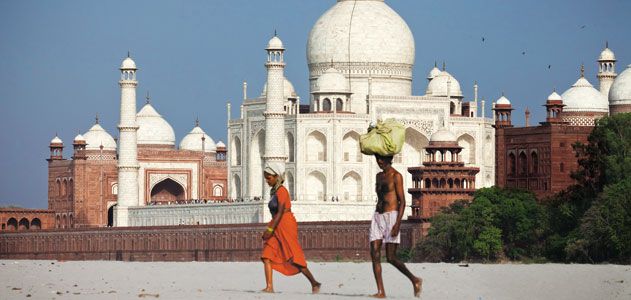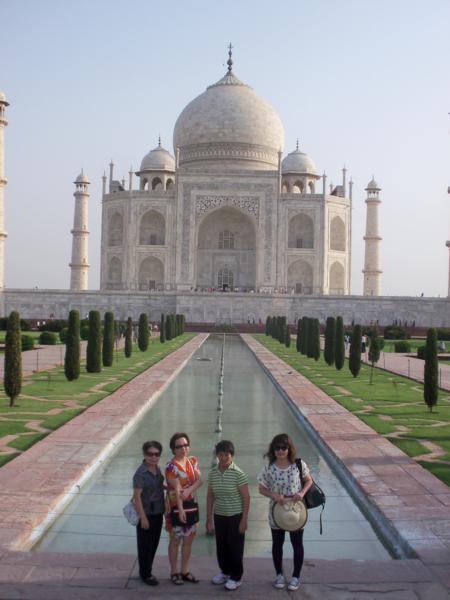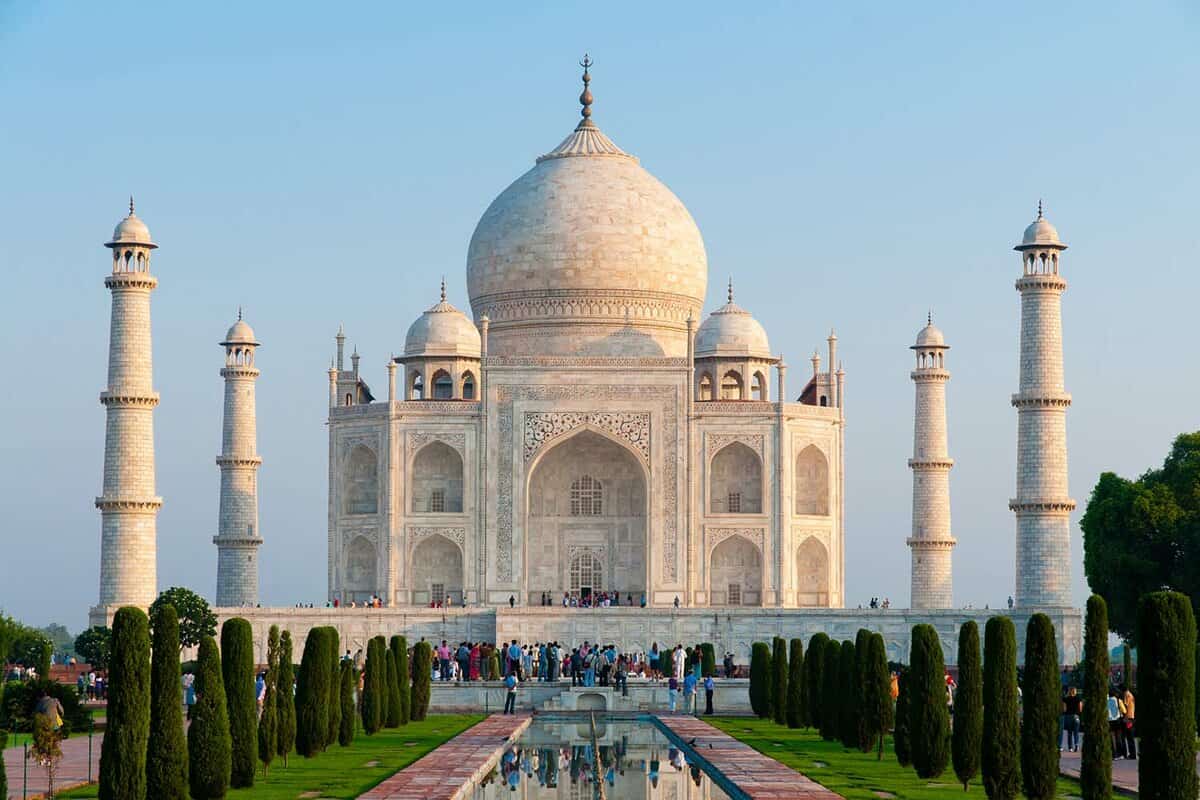Discovering the Majestic Taj Mahal: A Timeless Wonder

Are you ready to embark on a journey to one of the most iconic architectural marvels in the world? Brace yourself as we dive into the timeless wonder of the Taj Mahal.
The Majestic Taj Mahal: A Symbol of Love and Grandeur
Welcome to the Taj Mahal, an epitome of love, grace, and unparalleled beauty. Situated in Agra, India, this magnificent white marble mausoleum has captivated the hearts of millions of visitors from around the globe.
Built by Emperor Shah Jahan in the 17th century, the Taj Mahal is a tribute to his beloved wife, Mumtaz Mahal. Its symmetrical design, intricate carvings, and picturesque gardens make it an architectural masterpiece. As you approach its grand entrance, prepare to be mesmerized by its majesty.
A Brief History of the Taj Mahal
The construction of the Taj Mahal began in 1632 and took over 20 years to complete. Emperor Shah Jahan wanted to create a mausoleum, surpassing all others in its beauty and significance. Thousands of skilled craftsmen and labourers worked tirelessly to bring his vision to life.
The Taj Mahal is an enchanting blend of Persian, Islamic, and Indian architectural styles. Its central dome, four minarets, and intricate inlay work showcase the exceptional craftsmanship of that era. The mausoleum also houses the tombs of Shah Jahan and Mumtaz Mahal, symbolizing eternal love.
Visiting the Taj Mahal is a truly awe-inspiring experience. As you wander through its magnificent courtyards and admire the monument's reflection in the shimmering pool, you can't help but feel a sense of wonder and tranquillity.
So, pack your bags and embark on a journey to discover the timeless wonder of the Taj Mahal. Prepare to be enchanted by its grandeur, touched by a love story that defies time, and captivated by its architectural brilliance. The Taj Mahal awaits your presence.

Exploring the Extravagance
Exquisite Architecture and Design of the Taj Mahal
When you visit the Taj Mahal, you will immediately be captivated by its magnificent architecture and design. Built in the 17th century by Emperor Shah Jahan as a mausoleum for his beloved wife, Mumtaz Mahal, this UNESCO World Heritage Site is regarded as one of the greatest architectural achievements in the world.
The Taj Mahal uniquely blends Persian, Islamic, and Indian architectural styles. Its symmetrical design consists of a grand entrance leading to a beautiful garden and a central white marble structure. The delicate carvings and intricate details of the marble exterior are simply breathtaking.
Unveiling the Intricate Inlays and Decorations
As you step closer to the Taj Mahal, you will be amazed by the intricate inlays and decorations adorning the marble surface. The Taj Mahal is adorned with precious and semi-precious stones, including intricate floral and geometric designs crafted from vibrant gemstones such as jasper, onyx, and lapis lazuli. This level of meticulous craftsmanship is a testament to the skilled artisans of the Mughal era.
Inside the Taj Mahal, you will find a peaceful mausoleum chamber where the tombs of Emperor Shah Jahan and Mumtaz Mahal are located. The chamber is adorned with exquisite calligraphy and floral patterns, adding to the overall grandeur and beauty of the monument.
A visit to the Taj Mahal is not only an opportunity to marvel at its architectural splendour but also a chance to learn about the rich history and cultural significance it holds. Whether you're a history enthusiast, an architecture lover, or simply someone seeking beauty and inspiration, the Taj Mahal offers an unforgettable experience that will leave you in awe of its timeless wonder.

The Story Behind the Monument
Shah Jahan and Mumtaz Mahal: A Love Story for the Ages
Prepare to be captivated by the love story that inspired the creation of one of the world's most remarkable architectural wonders - the Taj Mahal. Built by Emperor Shah Jahan in memory of his beloved wife, Mumtaz Mahal, this monument is a testament to their eternal love.
Legend has it that Shah Jahan and Mumtaz Mahal shared an extraordinary bond. Mumtaz was not only his wife but also his confidante and trusted advisor. She accompanied him on his military campaigns, and it is said that her support and guidance helped shape some of the Emperor's greatest achievements. Tragically, Mumtaz passed away while giving birth to their 14th child. Devastated by her loss, Shah Jahan vowed to honour her memory most greatly.
The Construction of the Taj Mahal: Labour of Love
Shah Jahan began constructing the Taj Mahal in 1632 to fulfil his promise. The monument in Agra, India, took over 20 years to complete and involved an estimated 20,000 artisans and labourers. The Emperor spared no expense, importing white marble from Makrana, precious stones worldwide, and the finest craftsmen to bring his vision to life.
The Taj Mahal's architectural brilliance is a fusion of various styles, combining Persian, Islamic, and Indian influences. Its symmetrical layout, intricate marble inlay work, and meticulously crafted minarets are a testament to the skilled craftsmanship of the artisans involved.
Today, the Taj Mahal stands as a UNESCO World Heritage Site, symbolising everlasting love and architectural grandeur. Its stunning beauty attracts millions of visitors from around the world who come to marvel at its timeless splendour.
Visiting the Taj Mahal is a truly unforgettable experience. As you enter the majestic grounds and catch a glimpse of the glistening white mausoleum, you can't help but be in awe of the magnificence before you.
So, if you find yourself in India, include a visit to the Taj Mahal on your itinerary. It's a journey that will transport you back in time and leave you with memories to cherish forever.

Captivating Features
The Central Dome and its Architectural Brilliance
Taj Mahal, a true masterpiece and one of the remarkable wonders of the world, never ceases to amaze visitors with its captivating features. One of the most striking elements of this architectural marvel is its mesmerizing central dome.
The central dome of the Taj Mahal stands tall, proudly reaching towards the sky. Its elegant white marble design and intricate carvings showcase the genius of Mughal architecture. This iconic dome, with its intricate geometric patterns and delicate calligraphy, is a testament to the skilled craftsmanship and attention to detail of the architects and artisans involved in its construction.
The dome's design follows a symmetrical pattern, with four smaller domes surrounding it. It creates a stunning visual effect, especially during sunrise and sunset when the sunlight illuminates the white marble, making it glow with an ethereal beauty.
Gardens of Paradise: Charbagh and its Significance
Another enchanting feature of the Taj Mahal is its meticulously designed gardens, Charbagh. These gardens were inspired by the concept of paradise gardens in Islamic architecture and serve as a picturesque backdrop to the grand monument.
The Charbagh Gardens, also known as the "four gardens," are divided into quadrants by watercourses, creating a symmetrical layout. The lush greenery, pristine flower beds, and serene fountains add to the charm of the Taj Mahal, providing a serene and peaceful ambience.
These gardens not only enhance the beauty of the Taj Mahal but also hold deep symbolism. They are thought to represent the earthly paradise described in Islamic texts, where rivers flow, and gardens flourish. Walking through these gardens, visitors can experience a sense of tranquillity and harmony, mirroring the serene intentions of the Mughal emperor Shah Jahan, who built the Taj Mahal as a symbol of love and devotion to his wife.
Visiting the Taj Mahal and exploring its captivating features, including the central dome and the gardens of Charbagh, is truly a journey through time and a testament to the architectural brilliance of the Mughal era. Discover the majestic beauty of this timeless wonder and let its enchanting features leave you in awe.

Significance and Cultural Impact
As a traveller or history enthusiast, you may be enamoured with the majestic beauty of the Taj Mahal. This exquisite masterpiece is not only a beautiful structure but also holds significant cultural importance.
The Taj Mahal: A UNESCO World Heritage Site
The Taj Mahal, located in Agra, India, is a UNESCO World Heritage Site. It was designated as such in 1983 due to its outstanding universal value. Built by Emperor Shah Jahan in memory of his beloved wife, Mumtaz Mahal, it is considered one of the world's finest examples of Mughal architecture.
The architectural brilliance and intricate detailing of the Taj Mahal are awe-inspiring. The white marble mausoleum, accentuated by precious stones, reflects the love and devotion of Emperor Shah Jahan. Its symmetrical design, the central dome, and the surrounding gardens create a breathtaking sight.
The Taj Mahal in Popular Culture: Its Influence on Art and Media
The Taj Mahal has captured the hearts of millions of travellers and left an indelible mark on popular culture. Its timeless beauty has been featured in numerous films, books, and artworks.
Movies like "The Best Exotic Marigold Hotel" and "Veer-Zaara" have showcased the Taj Mahal, highlighting its romantic allure. Artists have depicted its splendour in paintings and photographs, capturing its charm.
Furthermore, the Taj Mahal has become a symbol of love and beauty. It inspires visiting couples worldwide to witness its mesmerizing aura and create lasting memories.
The Taj Mahal is a timeless wonder that continues to captivate people with its grandeur and significance. Whether you visit to admire its architectural brilliance or to experience the love story it represents, the Taj Mahal is an unforgettable destination that will leave you in awe.

Visiting the Taj Mahal
Planning Your Trip: Practical Tips and Guidelines
Are you planning a visit to the Taj Mahal? Get ready to immerse yourself in the magic of this timeless wonder! Here are some practical tips and guidelines to help you maximise your trip.
-
Timing is Everything: To avoid the crowds and enjoy the serene beauty of the Taj Mahal, consider visiting early in the morning or late in the afternoon. This will also allow you to witness the breathtaking sunrise or sunset over the monument.
-
Entry Requirements: Ensure you have the necessary documents for entry, such as a valid ID or passport. Foreign visitors must purchase an entry ticket, which can be obtained at the ticket counter.
-
Dress Code: Respect the cultural norms and dress modestly when visiting the Taj Mahal. Covering your shoulders and knees and avoiding wearing revealing clothing is advisable.
Experiencing the Taj Mahal: Must-See Areas and Activities
Once you enter the Taj Mahal, you will be transported to a world of exquisite beauty and craftsmanship. Here are some must-see areas and activities to enhance your experience:
-
Main Mausoleum: The main structure of the Taj Mahal is the breathtaking mausoleum itself. Explore the intricate marble work, admire the stunning calligraphy, and learn about the history and symbolism behind this architectural masterpiece.
-
Gardens and Reflecting Pool: Take a stroll through the well-manicured gardens and enjoy the peaceful ambience. Don't miss the chance to capture the iconic reflection of the Taj Mahal in the reflecting pool.
-
Viewpoints: For the perfect photo opportunities, head to the designated viewpoints to capture different angles and perspectives of the Taj Mahal. Remember to bring your camera and capture memories that will last a lifetime.
-
Local Culture and Cuisine: Immerse yourself in the local culture by interacting with the friendly locals, trying traditional Indian cuisine, and exploring nearby markets for souvenirs and handicrafts.
Remember, visiting the Taj Mahal is an experience like no other. Take the time to appreciate its beauty, learn about its history, and create lasting memories of this extraordinary monument.

Beyond the Taj Mahal
Exploring Agra: Other Architectural Marvels
As you soak in the magnificence of the Taj Mahal, don't miss the opportunity to explore other architectural marvels in Agra. The city is peppered with impressive structures that reflect the rich history and culture of the Mughal dynasty. Here are a few must-visit sites:
-
Agra Fort: This massive red sandstone fort, also known as the Red Fort of Agra, is a UNESCO World Heritage Site. Explore its palaces, gardens, and labyrinthine passages that once served as the seat of power for the Mughal emperors.
-
Itmad-ud-Daulah's Tomb: Often referred to as the "Baby Taj," this tomb is a stunning example of Persian architecture. Built entirely of white marble, it served as an inspiration for the design of the Taj Mahal.
-
Sikandra: Visit the tomb of Emperor Akbar, located in the suburbs of Agra. The fusion of Hindu, Christian, Islamic, Jain, and Buddhist architectural styles makes it a unique and fascinating monument.
Discovering the Charming Local Culture and Cuisine
While visiting Agra, take the time to immerse yourself in the vibrant local culture and indulge in the delectable cuisine. Here are a few experiences to consider:
-
Shopping for Handicrafts: Agra is famous for its intricate marble inlay work, carpets, textiles, and leather goods. Explore the bustling markets and bring home exquisite souvenirs crafted by skilled artisans.
-
Tasting Mughlai Delicacies: Agra is synonymous with the mouthwatering Mughlai cuisine. Don't miss the chance to savour delicious dishes like biryani, kebabs, and the iconic sweet petha.
-
Witnessing Folk Performances: Catch a live performance of traditional dance forms like Kathak or enjoy soulful Sufi music at one of the cultural centres in Agra.
Beyond the timeless beauty of the Taj Mahal, Agra offers countless experiences that will leave a lasting impression. So, go beyond the breathtaking monument and uncover the treasures of this enchanting city.
